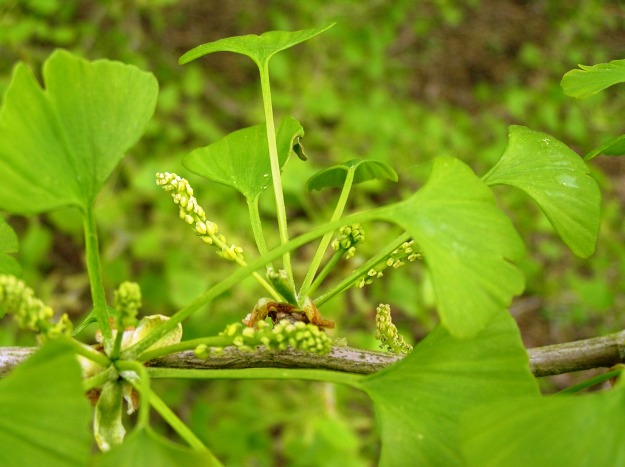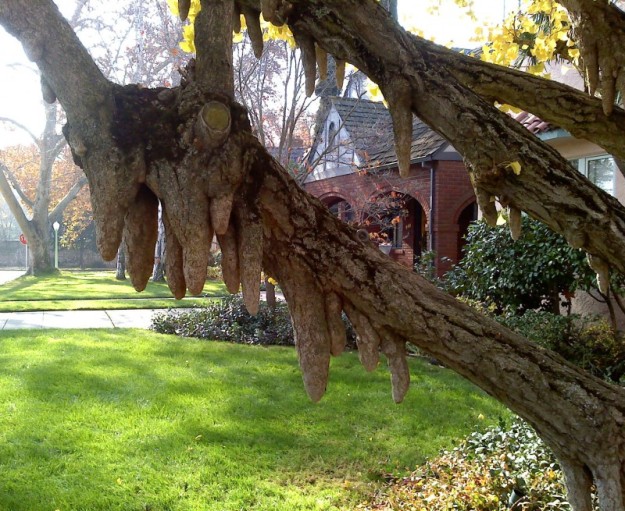Ginkgophyta is a plant division of non-flowering trees originating over 250 million years ago, in which all plants except for one, Ginkgo biloba, have become extinct. Ginkgo bilobas are large, deciduous trees with unusual looking cones and distinctive leaves, they can live for up to a thousand years. A few hundred million years ago whole forests existed around the world filled with different species of Ginkgos, but now the one remaining species is native only to China.
Ginkgophyta Family Tree
Leaves
Ginkgo leaves are bi-lobed, tough and more resistant to decay than other leaves. Some leaves are borne on long stems and turn yellow, die back in winter, then reappear in spring, while others are on shorter stems that may survive the winter.
Trunk and Vascular System
The bark of Ginkgos is fissured and the trunks may reach to 4m in diameter.
The vascular system of Ginkgos, and also conifers, are different to that of flowering plants. While flowering plants have a series of tube-like cells to conduct water, Ginkgos have connecting cells with tiny perforations, these are valves that close when water is in short supply so that turgidity is preserved.
Reproduction and Survival
Ginkgos are dioecious. The male cones grow from the shoot tip in clusters and release pollen. The female ovules (cones) appear in twos on the end of a stalk and do not look much like the cones of conifers. Each ovule has a drop of fluid, the pollination drop, that traps pollen to enable fertilisation.
Ginkgo sperm cells are motile, swimming to the ovule using thousands of hairs. This is something that occurs in cycads too (see previous blog) and in ferns, but not conifers or flowering plants, so is a throwback to a more primitive form of reproduction. Once fertilized the ovule grows into something resembling a fruit containing the seed.
Ginkgo seeds contain two cotyledons (seed leaves), but these never expand or emerge, instead they remain embedded in the seed providing nutrition for the seedling. The first leaves to appear above ground are true leaves with the distinctive Ginkgo shape, this is called hypogeal germination.
Ginkgos have a few clever ways of surviving and reproducing:
Like cycads, Ginkgos have been known to change sex, so that the male trees start producing ‘fruits’ and seeds. This is an effective way of propagating when there are no females around.
Ginkgos have a tendency to put out suckers from the ground that point upwards, but older trees sometimes also have odd downward growths, called Chichi, hanging from a single branch like stalactites. When these growths hit the ground they can start growing new roots and eventually form into a new tree, this is seems to be a form of reproduction for when the main tree is coming to the end of its life.
The brilliant photo above was taken by Rebecca Sweet and posted on Gossip in the Garden
If Ginkgos are hacked right back to the bare trunk they can regrow, either growing from the damaged stem or by putting out new shoots from the ground.
Ginkgos are also very resistant to pests, diseases, fires and pollution.
Medicinal Properties
Ginkgo biloba contains Flavonoids and Terpenoids which are naturally occurring chemical groups found in plants.
Flavonoids
Use for the plant: pigmentation, assisting in nitrogen fixation and cellular function
Use for humans: thought to have anti-allergic, anti-inflammatory, anti-microbial, anti-cancer and anti-diarrheal properties although this is not fully proved.
Terpenoids
Use for the plant: provide pigmentation and smell. They are thought to act as a deterrent to herbivorous insects and an attractant to insects that may eat herbivorous insects. They also are found in flowering plants and are used to attract pollinators. They may have antioxidant benefits for plants.
Use for humans: they have been used in traditional medicines for many years, although their effectiveness is not proved, they may have antibacterial properties and they may also have antioxidant benefits.
(note: I have been unable to ascertain exactly what Terpenoids and Flavonoids do in Ginkgo biloba specifically, so this information refers to their function in plants in general.)
Why do plants have medicinal properties?
We have enemies in common: plants have evolved chemicals that fight some of the same insects, fungi and bacteria that also plague humans.
Poisons can also be cures: mammals are often problematic for plants and so they have evolved ways to fight them off, but these ways may also, in small amounts, be cures. For example, Digitalis affects heart rate and is fatal in large amounts, but in small amounts can regulate heart rate.
While researching this question I have come across a common belief that plants evolved medicines in order to benefit humans, that by cultivating plants we made it beneficial for them to produce certain chemicals. However since plants first evolved 400 million years ago and evolved those chemical defenses millions of years ago, yet Homo sapiens only evolved a few hundred thousand years ago and only started cultivating plants 12,000 years ago, this isn’t really likely.
Further information about Ginkgos:
A very good website here, with clear pictures and video ( although the video is unfortunately difficult to hear):











